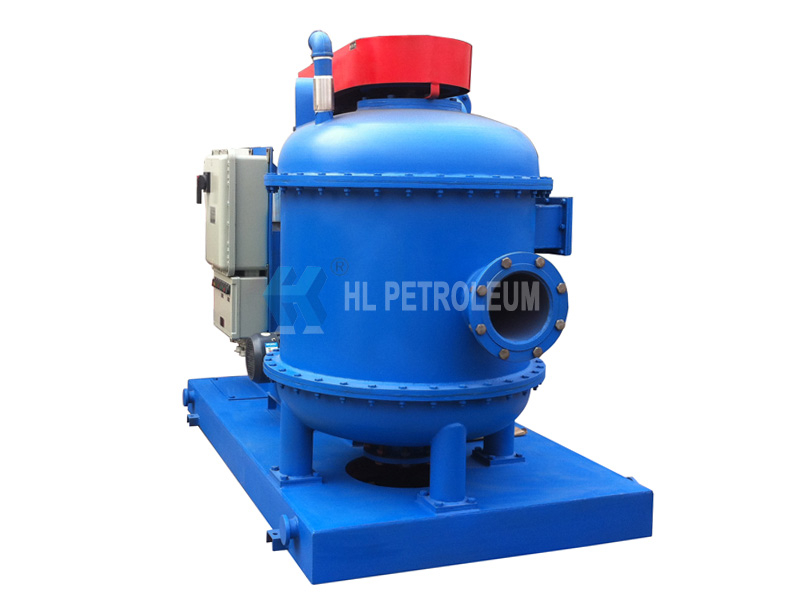| Name | Download |
|---|---|
| HL Product List.pdf | Download |

| Availability: | |
|---|---|
| Quantity: | |




Vacuum degasser is a specialized processing gas immersion fluid degassing equipment, the degassing efficiency is as high as 95%, suitable for all kinds of drilling solid control system of form a complete set, to restore the proportion of mud, the stability of mud viscosity performance, reduce drilling cost, has a very important role. At the same time, also can be used as a powerful blender.
HCQ series vacuum degasser used vacuum pump suction effect, cause negative pressure zone in a vacuum tank, mud under the action of atmospheric pressure, through the suction pipe into the hollow shaft of rotor, again by the window around the hollow shaft, the jet shaped into the tank wall, round due to the collision and separation effect, make the separation of drilling fluid into thin layer, immersed in the mud bubbles, gas evolution, through vacuum pump suction and the separation of gas water separator, the exhaust pipe line to the safety of gas by the separator, the mud by the impeller discharge outside the tank. Due to the main motor first starts, and motor connected state of a high-speed rotating impeller, so the mud can only from the suction pipe into the tank, will not be inhaled from the drainage pipe.
Vacuum Degasser Feature
Gas-water separator Vacuum tank
Water circulating pump Explosion Proof Control Box
Vacuum Degasser Technical Parameters
| Model | HCQ 240 | HCQ 270 | HCQ 300 | HCQ 360 |
| capacity(m³/h) | 240 | 270 | 300 | 360 |
| Vacuum ratio(MPa) | -0.030—0.045 | -0.030—0.050 | -0.030—0.055 | -0.040—0.065 |
| Vacuum pump power(KW) | 2.2 | 3 | 4 | 7.5 |
| Speed(r/min) | 860 | 870 | 876 | 880 |
| Applicable mud gravity(g/cm3) | ≤2g/cm3 | ≤2g/cm3 | ≤2.5g/cm3 | ≤2.5g/cm3 |
| Master motor power(KW) | 15 | 22 | 30 | 37 |
| Dimension | 1750×860×1500mm | 2000×1000×1760mm | 2250×1330×1650mm | 2400×1500×1850mm |
| Weight | 1100kg | 1350kg | 1650kg | 1800kg |
Contact Us
Tel: +86-29-88680837
Fax: +86-29-88680975
Mobile/Whatsapp/Wechat: +86-13735815206
E-mail: sales@hlsolidscontrol.com
Vacuum degasser is a specialized processing gas immersion fluid degassing equipment, the degassing efficiency is as high as 95%, suitable for all kinds of drilling solid control system of form a complete set, to restore the proportion of mud, the stability of mud viscosity performance, reduce drilling cost, has a very important role. At the same time, also can be used as a powerful blender.
HCQ series vacuum degasser used vacuum pump suction effect, cause negative pressure zone in a vacuum tank, mud under the action of atmospheric pressure, through the suction pipe into the hollow shaft of rotor, again by the window around the hollow shaft, the jet shaped into the tank wall, round due to the collision and separation effect, make the separation of drilling fluid into thin layer, immersed in the mud bubbles, gas evolution, through vacuum pump suction and the separation of gas water separator, the exhaust pipe line to the safety of gas by the separator, the mud by the impeller discharge outside the tank. Due to the main motor first starts, and motor connected state of a high-speed rotating impeller, so the mud can only from the suction pipe into the tank, will not be inhaled from the drainage pipe.
Vacuum Degasser Feature
Gas-water separator Vacuum tank
Water circulating pump Explosion Proof Control Box
Vacuum Degasser Technical Parameters
| Model | HCQ 240 | HCQ 270 | HCQ 300 | HCQ 360 |
| capacity(m³/h) | 240 | 270 | 300 | 360 |
| Vacuum ratio(MPa) | -0.030—0.045 | -0.030—0.050 | -0.030—0.055 | -0.040—0.065 |
| Vacuum pump power(KW) | 2.2 | 3 | 4 | 7.5 |
| Speed(r/min) | 860 | 870 | 876 | 880 |
| Applicable mud gravity(g/cm3) | ≤2g/cm3 | ≤2g/cm3 | ≤2.5g/cm3 | ≤2.5g/cm3 |
| Master motor power(KW) | 15 | 22 | 30 | 37 |
| Dimension | 1750×860×1500mm | 2000×1000×1760mm | 2250×1330×1650mm | 2400×1500×1850mm |
| Weight | 1100kg | 1350kg | 1650kg | 1800kg |
Contact Us
Tel: +86-29-88680837
Fax: +86-29-88680975
Mobile/Whatsapp/Wechat: +86-13735815206
E-mail: sales@hlsolidscontrol.com